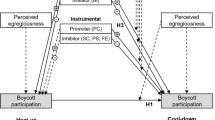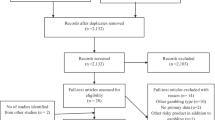Abstract
This study documents the rise and fall of boxing in Korea since its introduction in 1912. The participation of amateur athletes in boxing has decreased sharply since the 1980s. Also, the popularity of professional boxing among sports fans has diminished in recent decades. I consider boxing as a “product” that is “consumed” by individuals as participants and fans. I apply product life-cycle theory in analyzing the changing popularity of boxing. I argue that changes in the tastes of sports fans are closely linked to economic development, industrialization and standard of living. I present the rise in the popularity of soccer, baseball, and golf as illustrations of the changing tastes of consumers of sports that have accompanied economic development and social changes as well as the changing government policies on sports.
Similar content being viewed by others
Notes
Jay Coakley and Janet Lever, “Sport,” in Edgar F. Borgatta, ed., Encyclopedia of Sociology (New York: Macmillan, 2000), 2985.
Ibid.
Ibid.
Ibid.
Nicholas Dixon, “Boxing, Paternalism, and Legal Moralism,” Social Theory and Practice 27:2 (2001), 323–339; E. Dunning, “Figurational Sociology and the Sociology of Sport: Some Concluding Remarks,” in E. Dunning and C. Rojek, eds., Sport and Leisure in Civilizing Process (Toronto: University of Toronto Press, 1992), 221–284; Stephen Hardy, “Sport in Urbanizing America: A Historical Review,” Journal of Urban History 23:6 (1997), 675–709.
J. Coakley, Sport in Society: Issues and Controversies (Boston: McGraw-Hill, 2004), 35–39.
Ibid., 40–42.
Ibid., 53–55.
G.H. Sage, “Physical Education, Sociology, and Sociology of Sport: Points of Intersection,” Sociology of Sport Journal 14:4 (1997), 317–339; John Sugden, Boxing and Society: An International Analysis. (New York: St. Martin’s Press, 1996), 29–55; Jennifer Hargreaves, “Bruising Peg to Boxerobics: Gendered Boxing—Images and Meanings,” in David Chandler et al., eds., Boxer: An Anthology of Writings on Boxing and Visual Culture (Cambridge, MA: 1996), 121–131; J. Lever and S. Wheeler, “Mass Media and the Experience of Sport,” Communication Research 20:1 (1993), 299–313.
Loic Wacquant, “The Social Logic of Boxing in Black Chicago: Towards a Sociology of Pugilism,” Sociology of Sport Journal 9:3 (1992), 489–535; Loic Wacquant,. “A Fleshpeddler at Work: Power, Pain, and Profit in the Prizefighting Economy,” Theory and Society 27 (1998), 1–42.
Henry Assael, Marketing: Principles and Strategy (Chicago: Dryden Press, 1990), 312.
Ibid., 313.
Ibid., 315.
Ibid.
Ibid., 316.
Ibid.
Ibid.
Young-Il Na and Soo-Bum Son, “Growth of Boxing in Korea and Economic Development,” Korean Journal of History of Physical Education, Sport, and Dance 33:1(1998), 21–30 (in Korean); Gwang Ok, “The Political Significance of Sport: An Asian Case Study—Sport, Japanese Colonial Policy and Korean National Resistance, 1910–1945,” The International Journal of the History of Sport 22:4 (2005), 649–670; Soon-Chun Song and Hyung-Goo Son, “The History and Development of Boxing in Korea,” Martial Arts Studies 2 (1989), 87–100 (in Korean).
Song and Son, “The History and Development of Boxing in Korea,” 87–100.
Ibid.; Ok, “The Political Significance of Sport,” 663–666.
Ibid.
Ibid.
Song and Son, “The History and Development of Boxing in Korea,” 90.
Soo Beom Son, Changes in Korean Sports in Accordance with Economic Growth. (Unpublished Ph.D. Dissertation, Yong-In University, Korea, 2002), 141 (in Korean); Song and Son, “The History and Development of Boxing in Korea,” 91.
Ibid.
Ibid.
Ibid.
Ibid.
Song and Son, “The History and Development of Boxing in Korea,” 91–92.
Ibid., 92.
Ibid.
Ibid., 90–91.
The Korean Ministry of Information, A Handbook of Korea (Seoul, Korea: Ministry of Information, 1979), 286–287.
Song and Son, “The History and Development of Boxing in Korea,” 92.
Ibid.
Ibid.
Ibid., 93.
Ibid.
Jonghee Kim, The Political Ideology and Sport Policies of the Park Jung Hee Administration. Unpublished Ph.D. Dissertation, Hanyang University, Korea (1999) (in Korean); Jongweon Lee, A Study of Government Policies of the Third Republic and Development of Physical Education in Korea. (Unpublished Master’s Thesis, Seoul National University, Korea, 1997) (in Korean); Jongweon Lee,. An Analysis of the Sports Policies of the Fifth Republic in Korea (Unpublished Ph.D. Dissertation, Seoul National University, Korea, 2002) (in Korean).
Soo Beom Son, “Changes in Korean Elite Sports in Accordance with Economic Growth,” The Korean Journal of Physical Education 42 (2003), 26–28 (in Korean); Soo Beom Son, “Changes in Korean Pro-Sports in Accordance with Economic Growth.” The Korean Journal of Physical Education 43 (2004), 6–7 (in Korean).
Soo Beom Son, Changes in Korean Sports in Accordance with Economic Growth (2002), 142.
Son, Changes in Korean Sports, 142; [http://www.boxrec.com] (assessed on 21May 2005).
Byung Y Roh, Profiles in the 80-Year History of Boxing in Korea (Seoul, Korea: World Times, 1997), 138 (in Korean).
Ibid.
[http://www.boxrec.com/titlesearch.php] (Accessed on 21 May 2005).
Ibid.; Son, Changes of Korean Sports, 144.
Hyung Goo Son and Jeong Soo Kim, “A 80-Year History of Korean Boxing,” Review of General Education 3 (1998), 189–198 (in Korean).
[http://www.infoplease.com/ipsa/A0862313.html] and [http://www.athens2004.com/en/olympicmedals?noc=KOR] (Accessed on 28 May 2005).
Son, Changes in Korean Sports, 153.
Ibid., 159.
Na and Son, “Growth of Boxing in Korea and Economic Development,” 21–30; Son, “Changes in Korean Elite Sports,” 23–31.
Byung Soo Kim, Factors Affecting Sports Diplomacy in Korea (Unpublished Ph.D. Dissertation, Graduate School of Social Sports, Korea Sports University, 2001); Kang Ro Yoon, A War Without Gun Shots (Seoul, Korea: Sports Partners, 2006) (in Korean).
Son, “Changes in Korean Elite Sports,” 25–28.
Ibid., 27.
Ibid.
Ibid.
Ibid.
Ibid.
Ibid.
Son, Changes in Korean Sports in Accordance with Economic Growth, 144.
Carlo Rotella, “Good with Her Hands: Women, Boxing, and Work,” Critical Inquiry 25 (1999), 566–588; Won-Ki Kim, Man-Joong Jeon, and Sang-Ho Park, “A Study of Reflux of Boxing in Korea,” Korea Journal of History for Physical Education, Sport and Dance 12 (2003), 90–98.
Assael, Marketing: Principles and Strategy, 317–318.
Acknowledgements
An earlier version of this paper was presented at the International Conference on Globalization and Socio-Cultural Changes in Comparative Perspectives, co-hosted by the Korean Sociological Association and Center for Future Human Resources, Seoul, Korea, October 21, 2005. The author would like to thank two anonymous reviewers of the East Asia: An International Quarterly for their helpful comments and suggestions.
Author information
Authors and Affiliations
Corresponding author
Rights and permissions
About this article
Cite this article
Shin, E.H. State, Society, and Economic Development in Sports Life Cycles: The Case of Boxing in Korea. East Asia 24, 1–22 (2007). https://doi.org/10.1007/s12140-007-9008-x
Received:
Revised:
Accepted:
Published:
Issue Date:
DOI: https://doi.org/10.1007/s12140-007-9008-x




